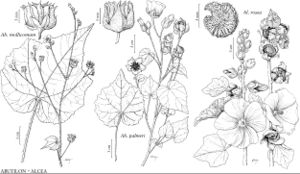Abutilon palmeri
Proc. Amer. Acad. Arts 8: 289. 1870.
Shrubs, to 1.5 (–2) m. Stems erect, ± stellate-pubescent, sometimes also with simple hairs 1–2 mm. Leaves: stipules filiform, 6–9 mm; petiole variable, usually subequal to blade; blade nearly concolorous, broadly ovate or weakly 3-lobed, 4–8 cm, ± as long as wide, base cordate, margins dentate, apex acuminate, surfaces softly tomentose. Inflorescences solitary flowers or terminal panicles. Flowers: calyx 9–15 mm, lobes accrescent to 20 mm, basally overlapping, not reflexed in fruit, cordate, to 8 mm wide; corolla yellow-orange throughout, petals 20–25 mm; staminal column glabrous; style 10-branched. Schizocarps broadly ovoid, 10–12 × 15–16 mm; mericarps: apex acute or apiculate, densely hirsute. Seeds 3 per mericarp, 3 mm, puberulent.
Phenology: Flowering late winter–spring.
Habitat: Desert habitats
Elevation: 0–1000 m
Distribution

Ariz., Calif., Mexico (Baja California), Mexico (Sinaloa), Mexico (Sonora), Mexico (Tamaulipas)
Discussion
Abutilon palmeri has become popular in cultivation. It is distributed from the Sonoran Desert to San Diego County, in the San Jacinto Mountains, and in the southern counties of Arizona.
Selected References
None.
Lower Taxa
"wide" is not a number.
